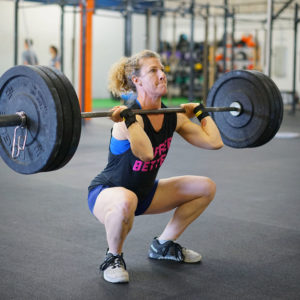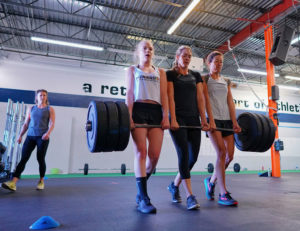Over the past few posts on An Effective Class Structure, we’ve dropped information on how to create an awesome affiliate experience through the hour group class. We’ve covered the whiteboard, the general warm-up, and the specific warm-up – which leads us to the next component of a class timeline – the workout.
It’s not uncommon for coaches to ask me, “I get how to coach the components of the class before the actual workout, but once the workout starts, what do I do, isn’t it hands off at that point?” Apply this logic to another realm – say, team sports. Imagine if teams practiced together with a coach evaluating and guiding them through every move; however, on game days, the coach didn’t come to the game, let alone coach. Some of the best coach and athlete development happens DURING the main event – and CrossFit workouts are no different.
A good coach is just as involved during the workout as they are during any other time in the hour, but it does take practice, and to some extent, it is a learned skill. Coaches need to intervene when the weights are too heavy or affect the athlete’s ability to get the correct intensity or range of motion. They need to push athletes to move faster and slow them down to get them to move better. Sometimes they even need to stop the athlete so they can show them something that will enable a safer or better training result.
In this post, we’ll give you five coaching musts and five things a coach should never do while coaching the workout.
Five Things A Coach Should Always Do
1. Coach
Coaches have to cue, correct, give feedback, make athletes slow down, go faster, and provide insight on pacing, sets, and strategy. I know what you’re thinking – “Duh, Nicole, you’ve already said that.” But let me elaborate.
A coach’s ability to coach on the floor is grounded in an established practice at the affiliate. I once had an athlete drop-in to my class. At the end, he said, “Thanks so much, I couldn’t get away with anything, you were calling me out on all of it!” After a moment, it occurred to me that my various cues to him during the workout including “squat lower,” “keep your heels together”, and “push away from the bar” weren’t seen as constructive coaching – he viewed them as me calling him out.
There is an important distinction in those two perspectives. As coaches, we have to establish to our athletes that giving them cues and feedback is not calling them out as if they did something wrong, it’s what coaching is! In another example, I’ve heard coaches say they don’t want to cue or correct athletes publicly on the gym floor because they don’t want to make them feel bad or embarrassed. Please, as professional coaches – we have to get beyond this. Athletes are not going to move flawlessly for quite some time, and the reason they are at your gym is that of the promise of improvement – not because of an expectation that they are already perfect. Your intention, body language, tone, and voice go a long way in how your athletes perceive your coaching and cues. You have to establish this mindset throughout your gym; it has to be done.
I’ve heard coaches say they don’t want to cue or correct athletes publicly on the gym floor because they don’t want to make them feel bad or embarrassed.
2. Encourage
Coaches have to encourage athletes. As much as we need to cue and correct athletes, we have to keep it fun and motivating. If we tip the scales toward mundane, robotic movement correction, people will stop having fun. And yes, it’s important to work hard and have fun. Your encouragement has to be genuine but let it fly when it moves you. I think this comes as a natural extension of loving your job as a coach – if excitement around an athlete’s accomplishment doesn’t move you to share your happiness with them – then think about why you’re there.
3. Keep it Safe
Coaches have to keep their crew safe. If an athlete’s form has deviated from what allows you to sleep at night, if the athlete can’t bring the bar back to their shoulder without the risk of smashing their collarbone, or if they are collapsing down on their neck in a handstand push-up like a pogo stick – step in! Sure, it can be a hard conversation, but it’s worth it, not only for the safety of your athlete but for the message you send to the gym as a whole – I’m here to get you fit but not at the expense of your safety.
4. Take a Stance
Coaches have to determine and enforce in their classes how much deviation from what they saw in the
warm-up to what the athlete executes in the workout they are willing to accept. Say an athlete does a set of front squats in the warm-up and it’s all there – depth, heels, knees, chest, barbell travels in a nice vertical line.

During the first two sets of an ascending weight 5×3 front squat workout, the athlete looks the same. On
the third set, they shift forward a bit, and the bar travels in a soft arch away from the body on the way up. On the fourth set, the same thing happens, but the upper back starts to round. Red flag. This much movement deviation from what was initially established is more than what I want to see for my athletes. In this instance, I would tell the athlete not to go up on their last set, perhaps even go down. Note that there’s a massive difference in the way a coach can communicate this information:
- “Hey, that’s too heavy, and the bar is pulling you forward, take 10lbs off the bar for your last set and lift your chest more to move better.”
- “Hey, that’s starting to look a little heavy, I don’t know if you need to go up the next set.”
The first statement is confident and decisive in how the coach wants the athlete to proceed. It’s not harsh; it’s straightforward. The second statement is wishy-washy and doesn’t give the athlete a clear answer as to what they are supposed to do. Left to their own devices, athletes will hear that statement as, “Cool, I can still go up.”
5. Do a Stimulus Check
Coaches have to evaluate whether or not athletes are getting “the good stuff” out of the workout. This includes athletes who need more weight and athletes who need to do less weight (or less rounds, etc.) to achieve the intended stimulus or time domain. This mainly happens before the workout but is still at play during the workout. If at three rounds in you know that the athlete is on pace to be well over the time domain, then pull some weight off for them!
Five Things a Coach Should Never Do
1. Be on Their Cell Phone
Cell phones have no place on a gym floor. It’s unprofessional. Texting, messaging, checking a call. It doesn’t matter your reasoning; your athletes view this scene as a coach who is checked out and you, despite your best efforts, will get caught in the “multitasking oblivious state of doom.”
2. Hang Out at the Front Desk
The front desk at CrossFit Roots is a magnet for hanging out and entertaining stuff in general, which is awesome, just not if you’re the one coaching class. What is first meant to be a quick sip of coffee at the desk or a quick word while athletes are transitioning to set-up equipment, ends up an involved conversation that pulls the coach away from their duties.
3. Workout with Their Class
I’m hesitant to even put this but even here in 2017 I hear about (and have experienced at other affiliates)

Whether there’s one person, three people, or twenty athletes in class, the role of the coach is not to workout with their athletes.
coaches working out with their classes. No matter the number of athletes in the class, a special occasion, or a “really awesome workout”, your job is to coach. That’s the service you’re offering. Also, your choice to workout with your class puts you in a position where people do not respect you as the coach and leader of the class – you are now equals.
4. Run Off to the Bathroom
Yes, there are instances where coaches coach numerous hours back to back, but you should strategically plan bathroom breaks in the 1-2 minutes between classes. Plan the end of your class such that you can run to the restroom before starting your next. During the workout is NOT the time to peace out to the bathroom.
5. Attempt to Have Hard Conversations During (or Immediately After) the Workout
When combative situations arise during the workout (which should be rare), it takes a confident and humble coach to table their immediate emotions and realize that little productive conversation will occur during the thick of a workout. Take the time after the workout to craft a well thought out email and schedule a time to meet in person to discuss.
I know we said five things a coach should never do, but here’s one more.
6. Perform Exercises or Stretches During the Workout
The workout is the time to coach – not to rub against the wall with a lacrosse ball or practice a few bar muscle-ups. The hour is not about you or your needs. Whatever skill you want to practice, muscle that needs stretching, or protein shake that needs mixing – the time to do that is never during the workout (or the class as a whole).
Download the full “Lessons for the Coaches at the Gym” eBook here.